The route into a conservation career can take many forms and can begin at any stage in life. The educational backgrounds of our interns and apprentices can vary, with many only finding out about this fascinating and rare vocation by chance – whether this is through an academic prospectus or even finding our social media pages for inspiration.
 Above: part of our conservation team, including interns, working on oil paintings in our Carlisle studio
Above: part of our conservation team, including interns, working on oil paintings in our Carlisle studio
The restoration of art, furniture, ceramics, and specialist materials is an ever-changing and engaging line of work, with a mixture of scientific and artistic skills. We’d like to introduce you to three of our junior conservators, including two interns at different stages of their academic journey and one apprentice who came to us through a college course. We hope that this will open your eyes to the many ways in which you can get into restoration and the wide variety of areas which exist within this field.
Above: a view of our oil painting and frame conservation space in our northern studio
Tom: Conservation Apprentice
Tom has worked in many aspects of our studio since beginning his apprenticeship through his local college. Before beginning this placement he had no idea that this historic and artistic line of work would be a possibility for him and has since been inspired to become a full time conservator. He works in our studio on frames and furniture and accompanies our art handlers around the country, helping to professionally remove and reinstall fine art, furniture and antiques of all kinds.
What made you choose art restoration?
When I came to my interview for the apprenticeship I met Chris and Anna (the owners of Fine Art Restoration Company) who were so welcoming and open. I was expecting an intimidating atmosphere because we are looking at such important historical objects and paintings, but everyone was so friendly. I felt right at home and wanted to stay as it is a lot more interesting than the normal career path into construction I might have otherwise taken. I feel really lucky to have found this opportunity.
 Above: Tom in our studio for his apprenticeship, helping with the care and restoration of frames under the guidance of experienced conservators
Above: Tom in our studio for his apprenticeship, helping with the care and restoration of frames under the guidance of experienced conservators
What has been your favourite project so far?
I love working with the gilded frames, especially the more detailed and extravagant ones. The treatments from stabilising the structure to colour-matching and aging the gold are always fulfilling when you see the before and after. I mostly enjoy the fact that there are always new items and artworks to see and you never know what you’ll come across next.
If you could restore anything in the future, what would you like to specialise in?
I think that the work we do with Banksy is amazing. I would love to work on a project like that in the future because it’s so unique and different from traditional work. I’m excited to see new and contemporary works and how we can help to protect them.
 Above: the techniques taught in our studio will help Tom to gain a strong understanding of conservation before beginning a professional course
Above: the techniques taught in our studio will help Tom to gain a strong understanding of conservation before beginning a professional course
Robert: Conservation Intern
Robert joined our team following his Bachelors in conservation and cultural heritage from University of Lincoln. He works on oil paintings in our studio under the guidance of senior conservators and performs many types of specialist treatments, including the tear repairs and surface cleaning of a wide variety of artwork.
 Above: Robert working on a complex tear to a large oil painting in our studio
Above: Robert working on a complex tear to a large oil painting in our studio
What led you to a career in art conservation?
I did an A Level in fine art and originally went to University of Lincoln to study art history, but one day we were given a tour of the conservation studio there and I realised that this line of work was a possibility. I spoke to my course leaders and swapped to a bachelor’s degree in conservation and cultural heritage. It was a great decision, as it was so much more vocational and hands on.
During this degree I got to spend a year abroad in Gothenburg, Sweden. This was connected to the cathedral and so I spent a lot of time working with church artworks and interiors such as historic doors and beams with painted designs.
We worked with a lot of different mediums during my course which gives me a lot of helpful background knowledge for all of the artwork which comes through the studio doors. I joined Fine Art Restoration Company through applying for an internship I saw on AIC and FAIC. I recommend to all aspiring conservators to sign up for their mailing list to get opportunities like this one.
 Above: the before and after of the large torn oil painting which Robert worked on in our studio
Above: the before and after of the large torn oil painting which Robert worked on in our studio
What has been your most complex project so far?
At university we did a course on ceramic restoration. I had a vase which was made with porcelain as thin as eggshell – restoring the pieces with the original finish was a very hard task. I’ve also been working on a large religious painting in the studio, this had a massive tear in the shape of a cross. It has been a long but successful process to bring the painting back to life.
Has anything surprised you in painting restoration?
Yes, I am always finding pine needles and tinsel behind artwork. It seems to be very popular to hang wreaths around them and I would suggest that not to do this, as the needles could pierce the back of the canvas or damage the paint layer over time if they are close against it.
I’m also surprised by how many large artworks are displayed with string, we often see this broken and a lot of damage to the painting or frame due to a fall from height. I once treated a large 18th century gilded mirror which had fallen down due to old string snapping; the details of the frame had been very badly shattered due to this accident.
Above: Robert and Ruth moving a large oil painting to be taken out of it’s frame ahead of restoration work
What do you look forward to in your career?
I’m interested to see what will happen to contemporary paintings in the future. I see many artworks being created today which will likely have severe and complex issues in the future, mostly due to the unusual techniques and materials which have been used. I expect that many of them might deteriorate because they will not be as strong as traditional oil paintings.
I love the work of Henri Rousseau, he was not much celebrated in his lifetime but is now such a famous name. I hope that I will be able to help preserve his work in the future.
 Above: a detail from Tiger in a Tropical Storm – Surprised! by Rousseau (1891), Robert would love to work on an artwork by Rousseau in the future
Above: a detail from Tiger in a Tropical Storm – Surprised! by Rousseau (1891), Robert would love to work on an artwork by Rousseau in the future
What are your top tips for getting into conservation?
Make as many connections as possible, this can be a good way to find out about job opportunities. Also sign up to job alerts and newsletters, and check websites such as ICON and AIC.
Above: Robert and Ruth gently cleaning the back of a canvas to clear away dust and contamination
Ruth: Conservation Intern
Ruth is one of our newest interns and came to us after finishing a bachelors in Fine Art at University of Leeds. We speak to her as she performs a surface clean on a large oil painting.
 Above: Ruth testing small areas of a painting to see which level of treatment it may require
Above: Ruth testing small areas of a painting to see which level of treatment it may require
What have you found out so far about this painting?
Yesterday I tested the surface to see which areas were dirty and then used tiny amounts of the different solutions to see which type of clean it needed. This helps everyone make an informed decision when it comes to making a treatment plan for the artwork.
I’ve discovered so far that some parts are dirty and some appear to be clean. This probably means it was part-cleaned by someone in the past. When I took it out of the frame yesterday with Robert, we found a fossilised bird behind the canvas! Wherever it has been, it has been hanging for a very long time. I hope we can find out more as the cleaning process continues.
Above: Ruth tests the oil painting with various solutions to see which level of surface cleaning may be appropriate
What made you pursue art conservation as a career?
I studied both practical art and art history modules at university, I especially enjoyed learning about special collections and artifacts. I have always really enjoyed history and wanted to find a way to bring this into my career. Nobody else I know from university has considered this, I feel lucky to have found a niche after the disruption of the arts during the COVID-19 pandemic. As part of my degree I got to study abroad in Krakow, this gave me opportunities to learn more about conservation in Europe.
When I was finishing my fine art degree I applied for many museums and galleries. I also would have liked to work in the university library, but everything was put on hold due to the pandemic lockdowns. Conservation and restoration services have been one of the sectors to see an increase in demand, so I sent a message to Fine Art Restoration Company to see whether I could gain experience through this internship programme. I’m excited that I get to see what a restoration studio environment is like before committing to the Masters degree in conservation.
 Above: Ruth cleaning the surface of a modern artwork in our studio
Above: Ruth cleaning the surface of a modern artwork in our studio
What has been your favourite aspect of painting restoration so far?
I really enjoy anything where we work together as a team. My favourite project to be a part of is the large religious painting which has a massive tear. One of the first treatments I was taught about by my studio colleagues was the re-lining of the canvas, which is something I never knew about before. The day by day process of each painting, especially this large one, is amazing to witness in person.
Above: Ruth found many interesting areas on this painting, some parts were dirtier than others and there was also some historic over-painting
Have you come across anything which has surprised you?
Yes, I am amazed that such devastating damage can be restored. When I see a badly water damaged painting brought back to life it proves that anything is possible, before working in the studio I would have never assumed it could be saved.
I’ve also learned that there is never one correct way to approach a painting, as they are all unique in their own way. Every artwork needs careful testing to get the best results because you can never predict what you might come across on the surface.
If you could restore a painting from any genre in the future, what would be your dream project?
My favourite genre is Russian Social Realism from the 19th century. I wrote my dissertation on this subject. I especially enjoy the work of the Peredvizhniki group of artists who protested against academic restrictions in their artwork. I would love to help preserve their paintings.
 Above: Barge Haulers on the Volga by Ilya Repin (1870–1873), Russian social realism is one of Ruth’s favourite subjects and she would be thrilled to work on a piece from this genre
Above: Barge Haulers on the Volga by Ilya Repin (1870–1873), Russian social realism is one of Ruth’s favourite subjects and she would be thrilled to work on a piece from this genre
Art conservation courses and training
Our team is always happy to answer questions and would like to share the following resources to help with your educational journey.
Object conservation degrees:
Painting conservation degrees:
Get in touch with our team
You can check our social media pages and website for upcoming placements, as well as sending us a copy of your CV and personal statement to [email protected] to keep on file for future opportunities
To make contact about restoration or advice please email us via [email protected] or call 0207 112 7576

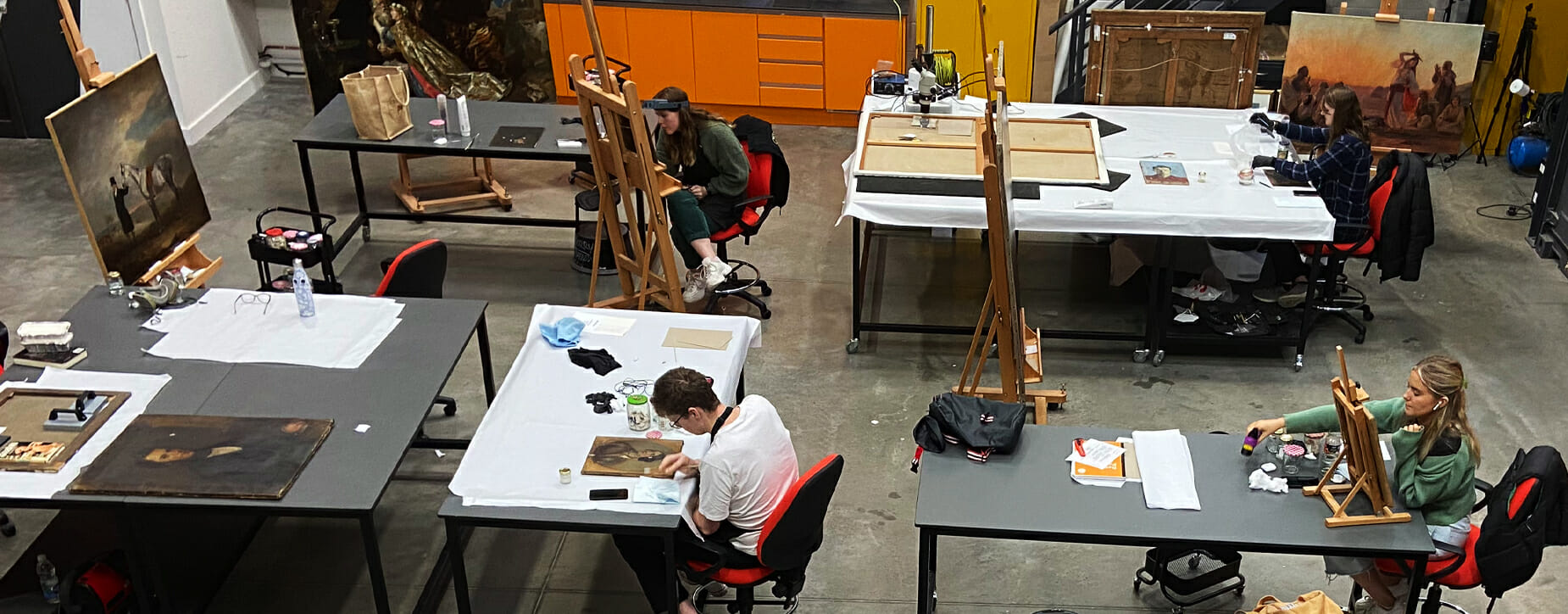 Above: part of our conservation team, including interns, working on oil paintings in our Carlisle studio
Above: part of our conservation team, including interns, working on oil paintings in our Carlisle studio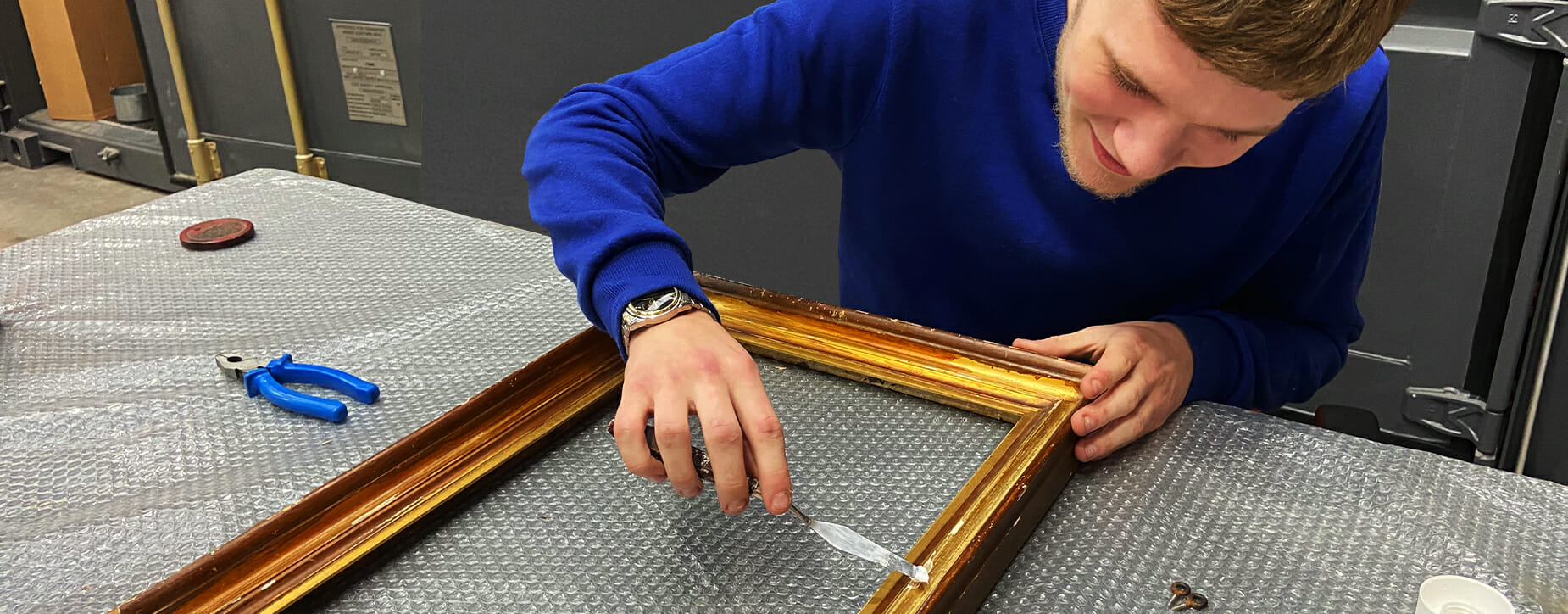 Above: Tom in our studio for his apprenticeship, helping with the care and restoration of frames under the guidance of experienced conservators
Above: Tom in our studio for his apprenticeship, helping with the care and restoration of frames under the guidance of experienced conservators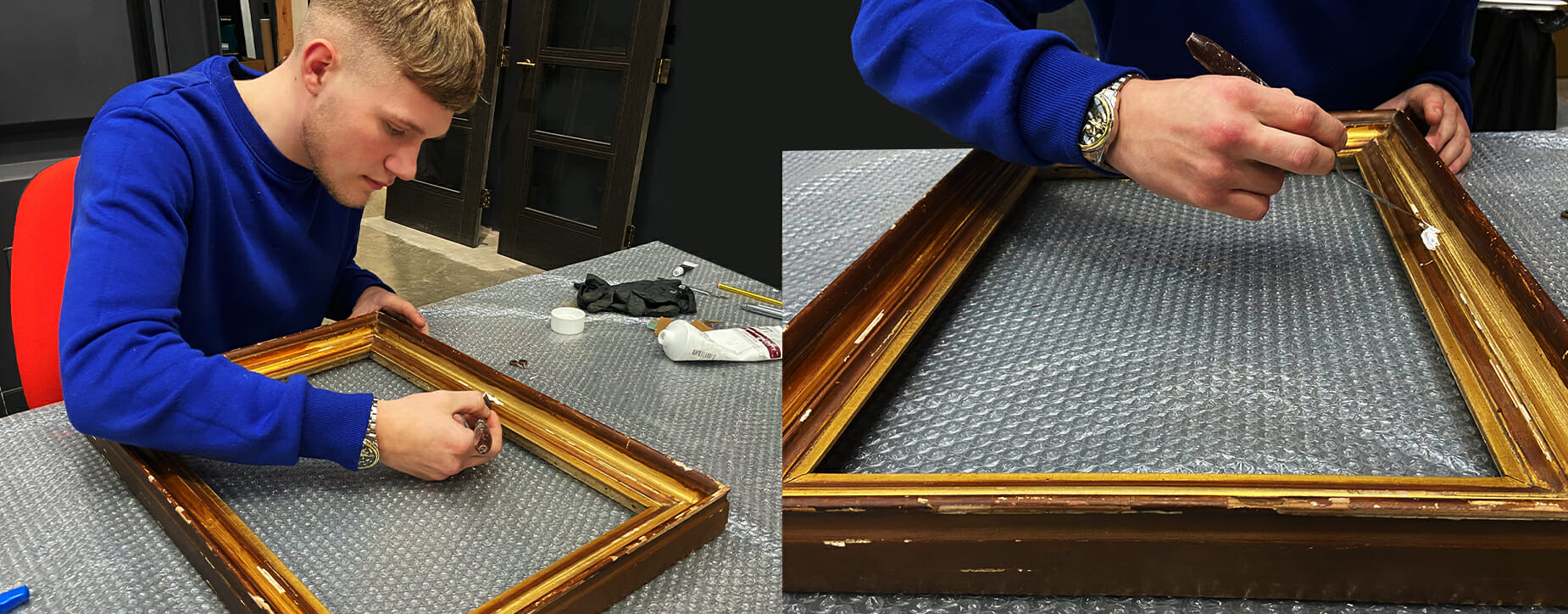 Above: the techniques taught in our studio will help Tom to gain a strong understanding of conservation before beginning a professional course
Above: the techniques taught in our studio will help Tom to gain a strong understanding of conservation before beginning a professional course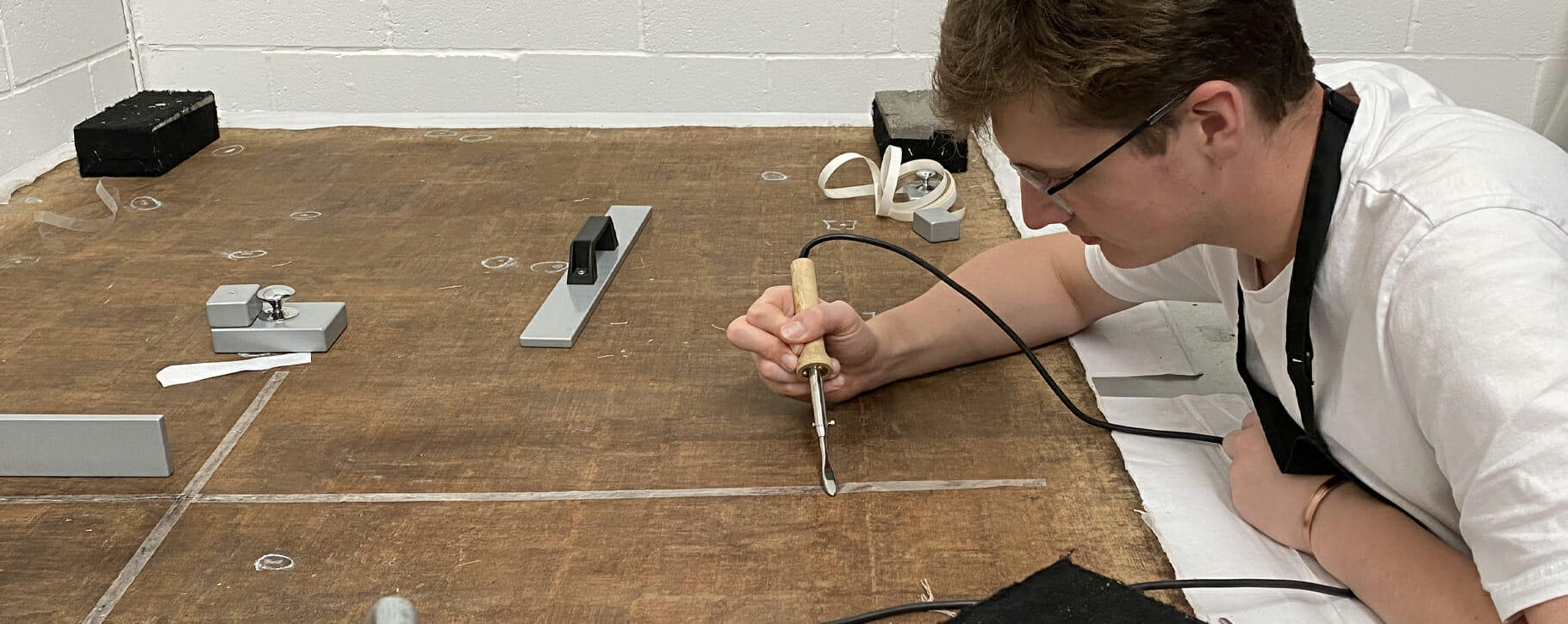 Above: Robert working on a complex tear to a large oil painting in our studio
Above: Robert working on a complex tear to a large oil painting in our studio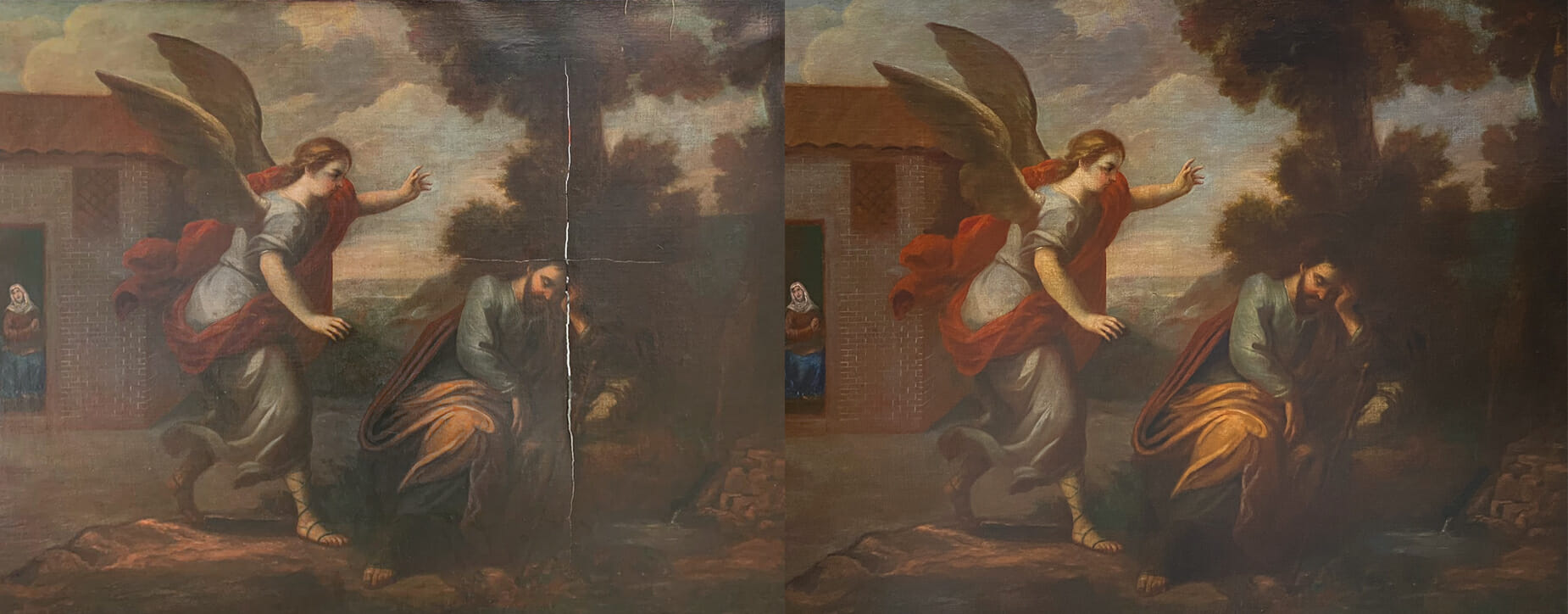 Above: the before and after of the large torn oil painting which Robert worked on in our studio
Above: the before and after of the large torn oil painting which Robert worked on in our studio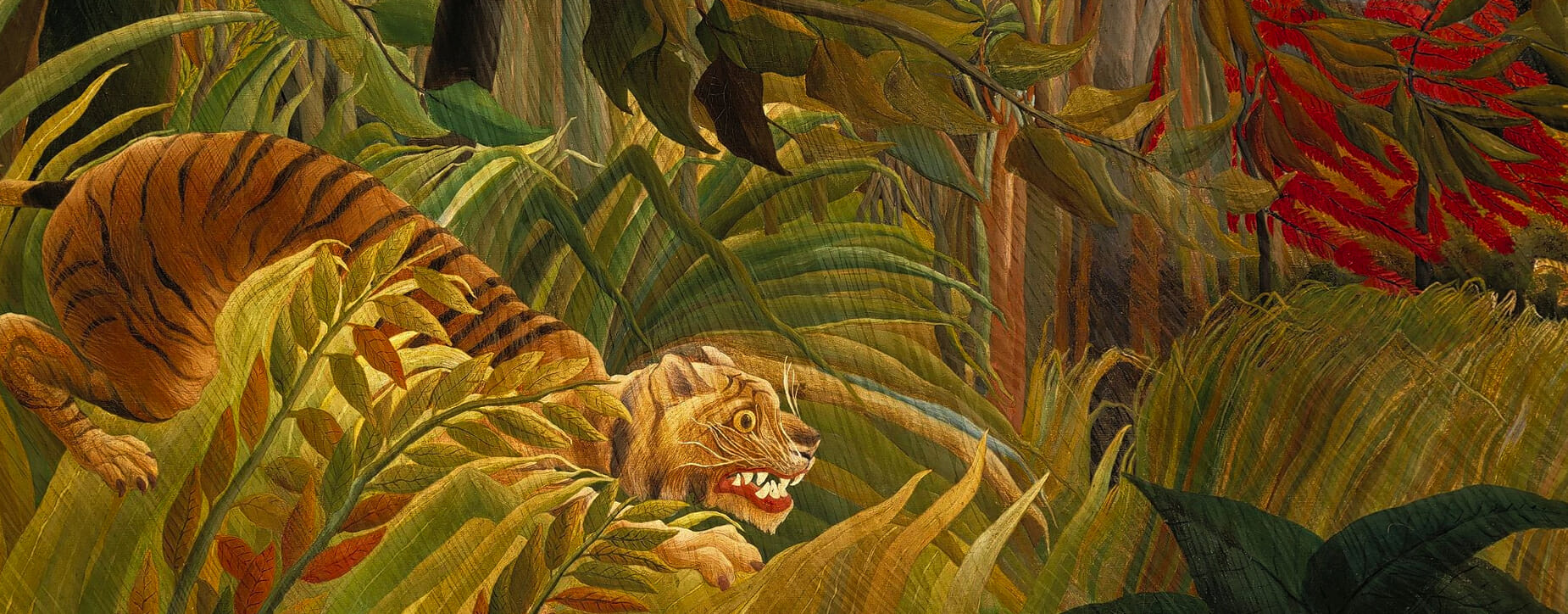 Above: a detail from Tiger in a Tropical Storm – Surprised! by Rousseau (1891), Robert would love to work on an artwork by Rousseau in the future
Above: a detail from Tiger in a Tropical Storm – Surprised! by Rousseau (1891), Robert would love to work on an artwork by Rousseau in the future Above: Ruth testing small areas of a painting to see which level of treatment it may require
Above: Ruth testing small areas of a painting to see which level of treatment it may require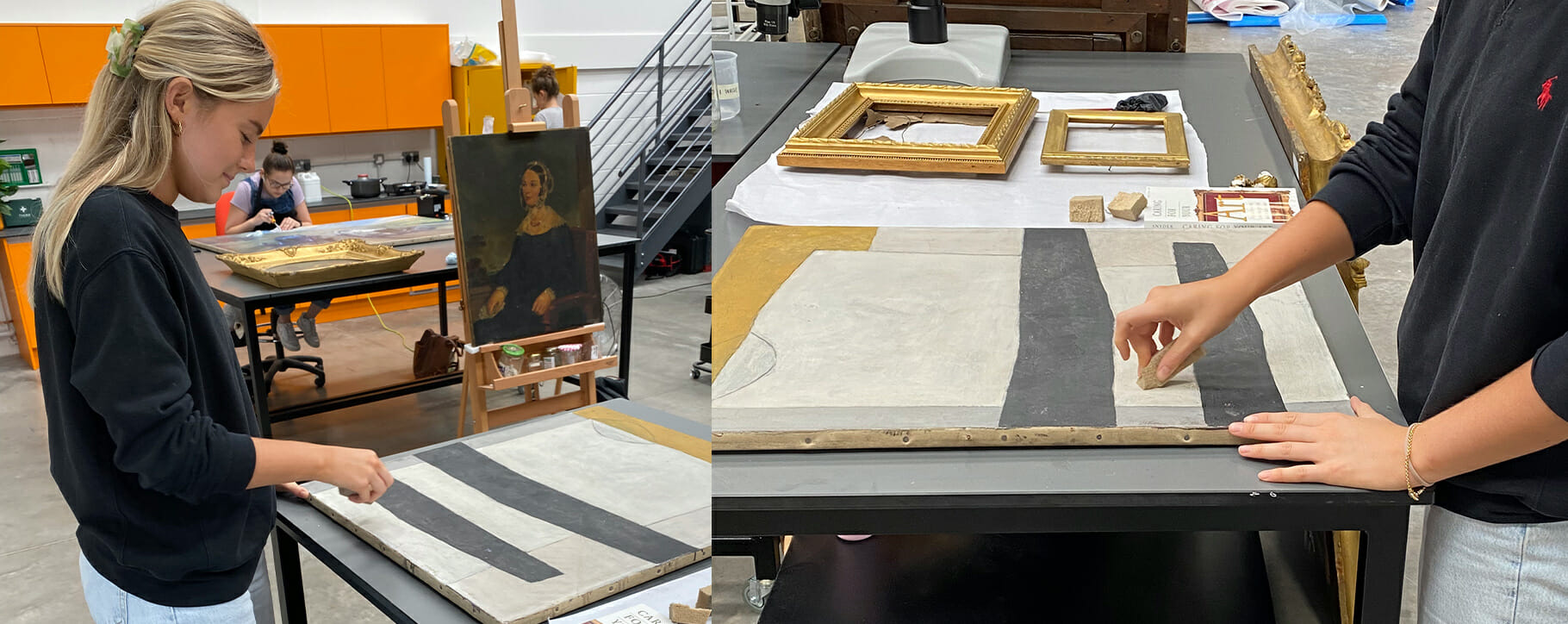 Above: Ruth cleaning the surface of a modern artwork in our studio
Above: Ruth cleaning the surface of a modern artwork in our studio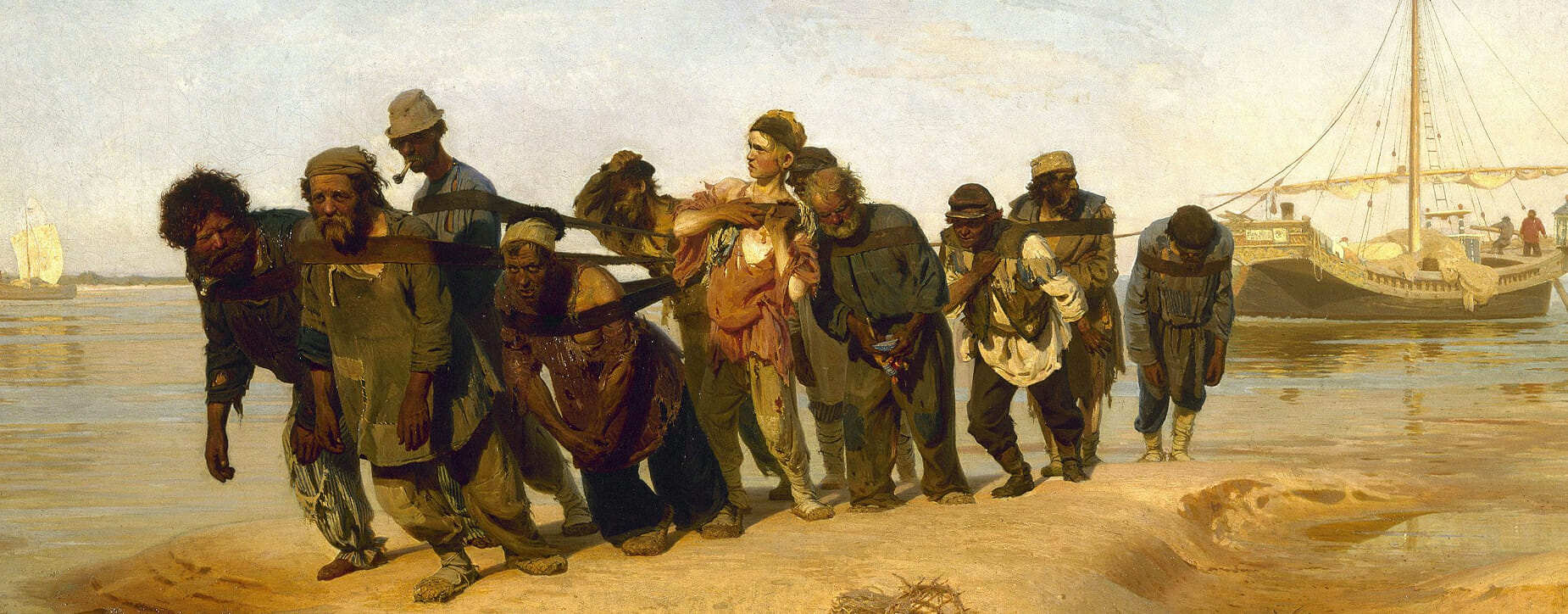 Above: Barge Haulers on the Volga by Ilya Repin (1870–1873), Russian social realism is one of Ruth’s favourite subjects and she would be thrilled to work on a piece from this genre
Above: Barge Haulers on the Volga by Ilya Repin (1870–1873), Russian social realism is one of Ruth’s favourite subjects and she would be thrilled to work on a piece from this genre




